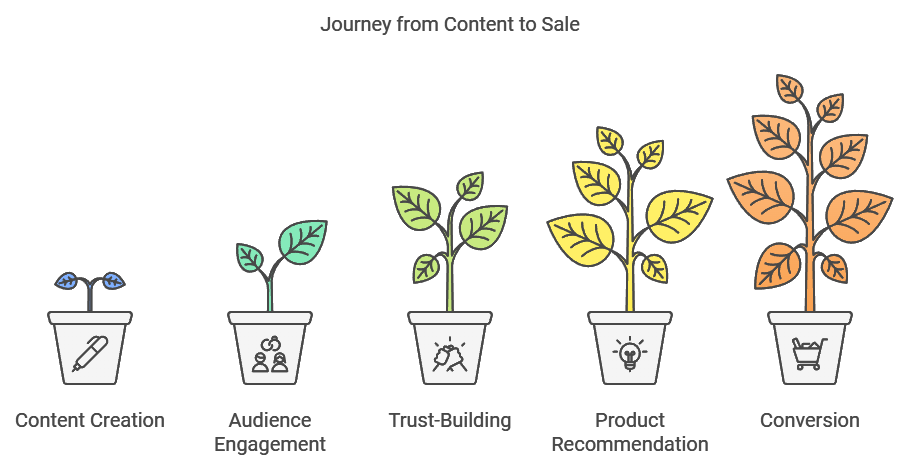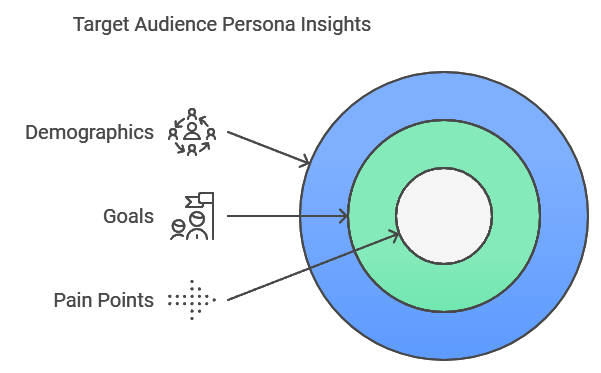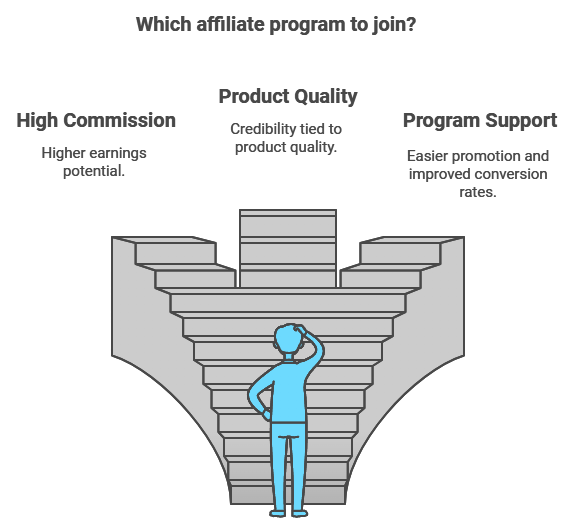Estimated reading time: 23 minutes
Affiliate marketing is rapidly growing, with billions of dollars generated annually by content creators. It’s no wonder so many people are turning to it as a way to generate passive income online. By creating powerful, value-driven content that tells a story, anyone can turn their passion into a revenue stream. Adding personal anecdotes, like my experience with affiliate marketing, can create a genuine connection with the audience. This approach helps achieve financial freedom while sharing products and services they genuinely believe in. But not all affiliate content is effective—successful affiliate content stands out by providing genuine value, solving problems, engaging the audience, and incorporating storytelling to connect on a personal level. This guide will help you achieve all of this and more.
In this post, we’ll explore how to create affiliate content that attracts visitors and converts them into loyal customers. Whether you’re just starting out or looking to improve your current approach, this guide will help you understand what makes affiliate content successful—such as value-driven storytelling and strategic SEO—and how you can leverage it for long-term gains. Now, let’s explore creating affiliate content that drives sales and engagement by focusing on authentic connections and strategic storytelling.
Section 1: Understanding Affiliate Content
What is Affiliate Content?
Definition and Importance
Affiliate content is digital content created to promote a product or service through affiliate links. This type of content can include blog posts, product reviews, tutorials, and videos. It is designed to educate and inform the audience while subtly encouraging them to make a purchase.
Affiliate content plays a critical role in bridging the gap between buyers and their needs. By providing informative and valuable content, affiliate marketers can establish trust and credibility, which increases the likelihood that readers will click on affiliate links and make a purchase.
Creating effective affiliate content is essential for generating sales because it provides genuine value to the audience. For example, a well-crafted ‘how-to guide’ or a detailed ‘product comparison’ can help readers make informed decisions. Readers are more inclined to take action when their needs are being addressed, and their questions are answered. Focusing on value rather than just promoting products can significantly boost conversion rates by building trust and demonstrating a genuine understanding of the audience’s needs.
Learn more about the importance of quality content in affiliate marketing.

Recommended Articles for you
Section 2: Types of Affiliate Content You Can Create
Types of Affiliate Content That Work
Blog Posts, Product Reviews, and Tutorials
Creating successful affiliate content often involves choosing the right format that resonates with your audience. Different formats work better for different target audiences, and selecting the appropriate type of content can make a significant impact on engagement and conversion rates. Here are some of the most effective types of affiliate content you can create:
- Blog Posts: Blog posts are versatile and can serve multiple purposes, from educating the reader to subtly promoting products. Long-form articles, listicles, and ‘how-to’ guides are particularly effective when focusing on specific keywords. Blog posts allow you to incorporate storytelling and in-depth analysis, making them ideal for products that require detailed explanation.
- Product Reviews: Product reviews are a powerful tool for affiliate marketers because they provide honest and detailed insights about the products. For example, tech gadgets and beauty products regularly benefit greatly from detailed reviews, as readers want to understand specific features and real-life usage experiences. Including both pros and cons helps build trust with your audience, as readers appreciate transparency. Effective product reviews typically include personal experiences, making the content relatable and persuasive.
- Tutorials and How-To Guides: Tutorials are highly engaging because they solve a specific problem for the reader. For example, complex products like DSLR cameras or home automation systems typically require tutorials to explain their features and functionalities in detail. They show exactly how a product can be used, offering value and clarity. This type of content is particularly useful for more complex products, as it helps break down usage into simple steps that the audience can easily follow.
- Video Content: Videos are becoming increasingly popular in affiliate marketing. Creating video reviews or ‘how-to’ tutorials allows for a more personal touch, enabling viewers to see the product in action. Videos can be especially effective on social media platforms, helping reach a broader audience.
Each type of affiliate content has its strengths depending on the niche and product. Marketers should consider factors such as product complexity and audience preferences when deciding which content format to use. For example, detailed tutorials may work well for complex tech products, while a simple lifestyle product might be best suited for a blog post or product review. For instance, a complex tech product may benefit from a detailed tutorial or video demonstration, whereas a simple lifestyle product might be effectively marketed through a blog post or a brief product review.
Check out this detailed guide on affiliate marketing content for more insights into the various forms of affiliate content and how they can be used effectively.
| Type of Affiliate Content | Effectiveness | Best Scenarios |
| Blog Posts | High | Great for explaining complex topics in depth, building trust, and targeting specific keywords. Ideal for products that require a lot of detail and context. |
| Product Reviews | High | Best for products where readers need an honest evaluation. Effective for tech gadgets, beauty products, and anything with multiple pros and cons. |
| Tutorials & How-To Guides | Very High | Excellent for complex products requiring in-depth guidance, like DSLR cameras or home automation systems. Helps solve specific problems for readers. |
| Video Content | Very High | Highly engaging and ideal for visually demonstrating product use. Works well for reaching broader audiences on social media platforms and YouTube. |
Section 3: The Step-by-Step Process for Creating Affiliate Content
How to Create Affiliate Content in 5 Steps
Step 1: Know Your Audience
Understanding your audience is the cornerstone of creating impactful affiliate content. Knowing your audience helps in crafting personalized messages that resonate deeply with their needs, making your content more effective. To truly connect with your audience, it’s essential to understand their unique needs, pain points, and aspirations.
Start by gathering insights into their challenges. For instance, if you’re targeting individuals looking to start a fitness journey, understanding their fears (e.g., lack of motivation or not knowing which equipment to use) allows you to create content that directly addresses those issues. For example, creating ‘A guide on choosing the best home fitness equipment for beginners’ can effectively tackle these concerns.
- Audience Relevance and Impact on Conversions: According to research by HubSpot, personalized content that addresses specific audience needs can increase conversion rates by up to 202%. Including a note about how personalized affiliate content can improve engagement and lead to higher conversions can make a compelling case for understanding your audience.
- Time Spent on Research: A survey from Demand Metric found that 78% of marketers say understanding audience needs leads to more successful content. Adding a stat like this in an info box can underline the importance of investing time in audience research.
- Content Success with Demographic Targeting: A recent survey conducted by Google Consumer Insights indicated that 63% of consumers expect brands to understand their unique needs and preferences. This statistic supports the importance of creating audience-specific content to boost affiliate success.
For more in-depth insights on understanding and targeting your affiliate marketing audience, check out this guide, which covers tips on defining audience demographics and effective targeting strategies.

Step 2: Choose the Right Product or Service
To create successful affiliate content, it’s crucial to select products or services that align with your audience’s needs and interests, as this alignment can significantly enhance how well your content resonates and converts.
Considerations for Product Selection:
- Audience Relevance: Ensure the product or service resonates with your target audience. It should solve a specific problem or fulfill a desire your audience has.
- Commission Rates: Look at the commission structure of potential affiliate programs. Higher commission rates can lead to greater earnings, but balance this with the value and relevance of the product. For example, a high commission on a low-quality product can hurt your credibility.
- Product Quality: Promote only high-quality products. Your credibility is tied to the quality of the products you recommend, so always vet them thoroughly.
- Program Support: Some affiliate programs offer better support, resources, and promotional tools. Choosing programs with features like affiliate dashboards, marketing templates, or dedicated account managers can make your job easier and improve conversion rates.
For more details on some of the best affiliate programs available, including tips on what to look for, check out this guide from HubSpot, which includes a list of top programs with detailed comparison criteria.

Step 3: Create Value-Driven Content
Creating value-driven content is essential for building trust and encouraging your audience to take action. Value-driven content not only educates, but also helps in building long-term relationships with your audience. Here are some key strategies to ensure your content provides value and promotes engagement effectively:
- Focus on Providing Genuine Value
- Understand Your Audience’s Needs: Tailor your content to directly address the needs and challenges of your audience. Consider using surveys, analytics tools, or social media insights to gather data on what your audience cares about most.
- Offer In-Depth Information: Provide thorough and insightful information to establish yourself as a reliable source.
- Maintain an Authentic and Conversational Tone
- Share Personal Experiences: Relate your content to your own experiences to create an authentic connection. For example, share a story about a time when a product helped solve a problem you faced, which can make your content more relatable and engaging.
- Avoid Aggressive Sales Language: Focus on educating and informing rather than pushing for a sale.
- Integrate Affiliate Links Naturally
- Contextual Placement: Include affiliate links within the context of helpful information rather than forcing them. For example, including a link in a product recommendation paragraph can ensure it fits naturally within the content.
- Use Descriptive Anchor Text: Make your links clear about what readers can expect when clicking.
- Limit the Number of Links: Avoid overloading your content with too many affiliate links, which can appear to be overly promotional.
- Learn how to integrate affiliate links effectively.
- Disclose Affiliate Relationships Transparently
- Always be clear about your affiliate relationships. Add a disclaimer at the beginning of the post or next to affiliate links. Transparency builds trust, which is crucial for conversions.
- Encourage Engagement and Feedback
- Respond Promptly: Address comments and inquiries in a timely manner to demonstrate your commitment to providing value and support.
- Ask Questions: Encourage readers to leave comments or share their thoughts to foster a community.

Step 4: SEO for Affiliate Content
Effective SEO is key to maximizing the visibility and conversion potential of your affiliate content. Let’s dive into the key areas of SEO that will elevate your affiliate content.
- Strategic Keyword Placement
- Title Tags: Incorporate primary keywords at the beginning of your title to improve search engine recognition and create a compelling title that encourages users to click, increasing engagement and contributing to improved rankings. For example, if promoting a fitness product, a title like “Best Home Fitness Gear for Beginners – Achieve Your Goals Fast” can effectively capture user attention while including primary keywords.
- Headings and Subheadings: Use keywords in H1, H2, and H3 tags to structure your content clearly and signal its relevance to search engines. This practice enhances readability, provides a logical flow for users, and boosts SEO performance.
- Content Body: Integrate keywords naturally throughout your content. Avoid keyword stuffing; instead, focus on providing valuable information that addresses user intent. Consider using tools like Yoast or Ahrefs to help maintain optimal keyword density and ensure natural integration. For instance, instead of repeating “fitness band” excessively, you can use related phrases like “exercise band” or “resistance band” to maintain a natural tone.
- Crafting Compelling Meta Descriptions
- Incorporate Keywords: Include primary keywords naturally within the first 150–160 characters to align with common search queries. This helps search engines understand the relevance of your page and encourages users to click when they see a keyword match. (Source: Proofed)
- Engage Readers: Write concise, informative descriptions that accurately reflect your page content while enticing users to click. Avoid common pitfalls such as being too vague or misleading, which can lead to high bounce rates and decreased trust. Ensure your meta description speaks directly to user intent. For example, “Discover the top-rated home fitness gear that helps you achieve your health goals effectively” makes a clear promise that encourages action. Avoid overloading with keywords to maintain readability.
- Optimizing Image Alt Text
- Descriptive Alt Text: Provide clear and concise descriptions of your images, incorporating relevant keywords where appropriate. This practice helps search engines understand your image content and makes your site more accessible to visually impaired users. For instance, instead of “image1.jpg,” use “woman using a resistance band for strength training.”
- Contextual Relevance: Ensure that the alt text accurately represents the image and its context within your content. This helps improve user experience and supports SEO without stuffing irrelevant keywords. For example, if the image shows a specific exercise, describe it in a way that makes sense within the content: “Man performing lunges with dumbbells in a home gym setting.”
- Incorporating Relevant Links
- Internal Links: Link to other relevant pages on your site using natural anchor text. This helps distribute keyword relevance across your site and improves navigation, keeping users engaged with your content for longer. For example, “Check out our guide on setting up a home gym” can help direct readers to related content naturally.
- External Links: Link to reputable sources to add credibility to your content and provide additional value for your readers. Make sure that external links open in a new tab to keep users on your site while allowing them to explore the referenced content. For instance, linking to research articles or industry statistics can reinforce the reliability of your claims.
- Prioritizing Readability and Natural Keyword Integration
- Write for Humans First: Your primary focus should always be on crafting content that is engaging and easy to read. Break up large blocks of text with bullet points, short paragraphs, and subheadings. For example, when discussing the benefits of a product, use bullet points to list each benefit clearly. This makes complex information easier to digest and helps keep readers engaged. Using formatting techniques like bold text can also draw attention to key points and improve the overall user experience. For example, using bullet points when listing the benefits of a product makes it more digestible.
- Natural Keyword Usage: Keywords should be seamlessly incorporated into your content. Use synonyms and related terms to maintain a natural flow and avoid sounding repetitive. For instance, instead of repeating “affiliate marketing tools,” you could use terms like “affiliate tools” or “marketing resources.” This helps maintain readability and signals semantic relevance to search engines.
Key Takeaways
- Keyword Placement Matters: Utilize keywords effectively in titles, headings, and body content to improve SEO visibility without compromising readability.
- Meta Descriptions and Alt Text: Make sure your meta descriptions and alt texts are concise, informative, and keyword-rich to engage readers and enhance discoverability.
- Linking and Readability: Use internal and external links wisely, and always prioritize content that’s easy to read, naturally integrating keywords to keep the audience engaged.
By following these strategies, you can enhance the SEO of your affiliate content, helping it reach a wider audience while boosting engagement and conversions.
Step 5: Promoting Your Content
Promoting your affiliate content is just as important as creating it. The right strategies will ensure your content reaches the widest possible audience, driving both sales and engagement. For insights into effective traffic sources to boost your content’s visibility, Adsterra provides a comprehensive guide on best traffic sources for affiliate marketing. Let’s explore some of the best ways to promote your affiliate content:
1. Social Media Marketing
- Platform Selection: Choose social media platforms that align with your target audience. For example, Instagram and TikTok are excellent for engaging with younger audiences, whereas Facebook and LinkedIn are more versatile, appealing to a broad spectrum of demographics. Experiment with different platforms to identify which ones perform best for your specific audience.
- Consistent Engagement: Consistency is key. Regularly share your affiliate content, ideally on a daily or weekly basis, engage with your followers through comments and messages, and participate in relevant groups or communities at least once a week to keep your audience engaged. Building these relationships is critical for establishing trust and credibility.
- Visual Appeal: Social media is a visual space. Use high-quality images, videos, and visually engaging graphics to capture attention and convey your message effectively. Remember, content that looks great is more likely to be shared.
2. Email Marketing
- Build a Quality List: A high-quality email list is foundational to your success. Encourage website visitors to subscribe to your newsletter by offering valuable incentives like exclusive content, discounts, or free guides. The more relevant your audience is, the better your engagement and conversion rates.
- Personalized Content: Tailor your email campaigns by segmenting your subscribers based on their interests and behaviors. This ensures that every email sent resonates with the reader. For example, you could segment by customer buying behavior and send targeted product recommendations accordingly.
- Clear Call-to-Action (CTA): Every email should have a purpose. Include compelling CTAs that clearly guide readers on what to do next—whether it’s visiting your latest blog post, checking out a product review, or sharing the content. Make your CTAs direct and valuable, such as, “Get exclusive access now” or “See why 1,000+ others love this product.”
3. Search Engine Optimization (SEO)
- Keyword Research: Conduct thorough keyword research to identify terms your audience is searching for. Integrate these keywords into your content to improve its visibility in search engine results. The better your keywords align with search intent, the higher the chances of driving targeted traffic.
- On-Page Optimization: Ensure all elements of your content are optimized. Use appropriate headings, craft compelling meta descriptions, and add descriptive alt text to images. These elements play a huge role in both user experience and search engine optimization, helping your content rank better.
- Quality Backlinks: Backlinks remain a powerful SEO tool. Reach out to reputable websites for backlinks to your content. High-quality backlinks can significantly boost your domain authority, helping your content appear higher in search results.
4. Building Organic Traffic
- Content Consistency: Publishing high-quality content regularly helps in building organic traffic. Focus on addressing your audience’s most pressing questions and needs. Consistent content, over time, positions you as an authority in your niche, making readers more likely to trust and revisit your site.
- Engage in Online Communities: Join and actively participate in forums, blogs, and social media groups relevant to your niche. By answering questions and providing value in these communities, you’ll establish credibility and subtly promote your content. It’s about genuinely helping people first.
- Guest Blogging: Guest blogging is a powerful method to drive traffic. Write articles for reputable websites in your industry, and include backlinks to your own content. Reach out to blog owners with a personalized pitch explaining how your content can add value to their audience. To find reputable sites, consider using tools like Ahrefs or simply search for top blogs in your niche that accept guest posts. Guest posts introduce you to a wider audience and drive visitors back to your own site, enhancing credibility and visibility.
5. Leveraging Your Audience
- Encourage Sharing: Make it easy for your audience to share your content. Include social sharing buttons and encourage readers to share useful pieces of content. Word-of-mouth remains incredibly powerful, and a well-timed social share can introduce your content to entirely new audiences.
- User-Generated Content: Foster community by inviting your audience to contribute. This could mean collecting testimonials, reviews, or even inviting followers to share their experiences using a specific product. For example, ask your audience to share photos of themselves using your product with a branded hashtag to encourage participation and create a sense of community. User-generated content provides social proof and deepens audience engagement.
- Engage with Feedback: Respond promptly to comments, questions, and other forms of feedback. Engaging with your audience helps to build trust and loyalty, which ultimately drives repeat traffic. Even criticism can be an opportunity to show how responsive and customer-focused you are.
Section 4: Common Mistakes to Avoid
Avoid These Mistakes When Creating Affiliate Content
Creating affiliate content that genuinely resonates with your audience and drives conversions requires more than just knowing the basics. Avoiding common pitfalls, such as being too promotional or neglecting SEO, is essential for ensuring your content is effective, valuable, and trustworthy. For a detailed overview of the most common affiliate marketing mistakes and how to avoid them, you can check out this comprehensive guide from BloggersPassion. Here are the key mistakes to avoid when creating affiliate content:
Mistake 1: Being Too Promotional
Affiliate content should not come off as a hard sales pitch. Overly aggressive promotion can easily turn readers away, making them feel like they are being pressured into buying something, e.g., using repeated calls to action or exaggerated claims. Instead of sounding like an advertisement, your content should be informative and helpful. Focus on addressing the reader’s needs and providing value. For instance, instead of just listing the product features, explain how it solves specific problems that your audience faces. A reader is much more likely to engage with content that feels genuine and solution-oriented.
Mistake 2: Not Providing Enough Value
Successful affiliate content is value-driven. If you don’t provide genuine value, your readers will have no reason to trust you or follow your recommendations. This means addressing their concerns, answering their questions, and offering actionable insights that make their lives easier, such as providing step-by-step instructions on how to use a product. For example, instead of just telling your audience about a product, include a detailed tutorial on how to use it effectively or share a personal story about how it benefited you. Value-rich content helps build trust, which is critical for driving conversions.
Mistake 3: Ignoring SEO
Ignoring SEO can significantly limit the reach of your affiliate content. No matter how well-crafted your content is, if it doesn’t follow basic SEO practices, it won’t rank well in search results, and potential readers will struggle to find it. Make sure you conduct thorough keyword research using tools like Google Keyword Planner or Ahrefs, and integrate those keywords naturally throughout your content. Also, ensure your content is well-structured, using headings, bullet points, and optimized meta descriptions. Remember to include alt text for images and use internal and external linking to enhance your SEO and improve user navigation.
Mistake 4: Not Disclosing Affiliate Relationships
Transparency is essential for maintaining trust with your audience. Failing to disclose your affiliate relationships can make readers feel deceived if they find out after clicking a link. Always include a disclaimer at the beginning of your content or next to affiliate links to clearly inform your readers about your relationship with the product or service. This practice builds credibility and helps establish an honest relationship with your audience, which is crucial for long-term success.
Mistake 5: Ignoring the User Experience
User experience is key to retaining your readers and encouraging conversions. Content that is cluttered, difficult to read, or not visually appealing will push readers away. Make your content visually appealing by using clear headings, plenty of white space, and easy-to-read fonts. Use short paragraphs, bullet points, and images to make your content more readable. For example, a well-placed image can break up text and make your article more engaging. Moreover, ensure your site is mobile-friendly since a significant portion of traffic now comes from mobile devices. A positive user experience encourages readers to stay longer on your page, increasing the likelihood of conversions.
Mistake 6: Choosing Products That Don’t Align with Your Audience
One of the biggest mistakes affiliate marketers make is promoting products that don’t align with their audience’s needs or interests. Promoting irrelevant products can harm your credibility and reduce the trust you have with your readers. Make sure to carefully select products that fit with your audience’s goals and solve their specific problems. For example, if your audience is interested in sustainable living, promoting eco-friendly products would resonate well, whereas promoting unrelated tech gadgets might not.
Mistake 7: Overloading Content with Affiliate Links
While it’s important to include affiliate links, overloading your content with too many can make it feel spammy and reduce its credibility. Instead of adding links at every possible opportunity, strategically place them where they naturally fit into the content. Ensure each link adds value, such as leading to a product review or a helpful guide, rather than overwhelming the reader with options. Quality over quantity is key when it comes to affiliate links.
Conclusion
Successful affiliate content hinges on three key factors: providing genuine value, deeply understanding your audience, and building trust. Throughout this guide, we’ve explored the essential steps to take—starting from knowing your audience and choosing the right products. We also covered how to craft content that resonates, optimize it for search engines, and promote it effectively. Each of these steps plays a critical role in ensuring that your affiliate content attracts readers and converts them into loyal customers.
Well-crafted affiliate content holds immense potential for generating passive income. For instance, an in-depth product review or a well-researched tutorial can generate consistent income over time. By focusing on storytelling, authenticity, and solving specific problems—like helping readers pick the right tools for their needs—you can establish yourself as a trusted source in your niche, leading to consistent conversions and a rewarding income stream.
If you’re ready to start creating your own affiliate content, start today to begin building your path to financial freedom sooner. Apply the strategies outlined in this guide, and turn your content into a powerful tool for financial independence. Remember, every piece of content is an opportunity to connect, provide value, and grow your passive income journey—so take that first step today!
Call to Action
If you’re ready to transform your content into a revenue-generating powerhouse, start today and unlock the potential for financial independence and flexibility. Take the first step towards your affiliate marketing journey today. Enroll in my free course: Mapping Your 9-5 Exit Strategy, where you’ll learn practical steps to achieve financial independence and take control of your future.
This course is designed to help you confidently transition from your 9-5 job to building a successful affiliate marketing business. It covers key topics such as content creation strategies, audience targeting, and effective promotional techniques, giving you the tools you need to succeed in affiliate marketing.
Frequently Asked Questions (FAQ)
Writing content for affiliate marketing involves understanding your audience, addressing their needs, and recommending products in a natural, helpful way. Begin by focusing on topics that resonate with your audience’s interests, and use relevant keywords to help your content rank well on search engines. Consider using tools like Google Keyword Planner or Ahrefs to identify the most effective keywords. It’s important to blend storytelling with genuine product insights to make the content engaging. Structure your content with headings, short paragraphs, and bullet points to improve readability, and always include a clear call-to-action that guides readers to take the next step.
The best content for affiliate marketing depends on your audience and the products you’re promoting. However, some popular and effective types include product reviews, comparison guides, tutorials, and listicles. Product reviews allow you to provide an in-depth look at the benefits and potential drawbacks of a product, such as reviewing a popular fitness tracker to discuss its features and real-world performance. Tutorials and how-to guides show readers exactly how to use a product to solve their problems, like creating a step-by-step guide on setting up a new smart home device. Listicles, like “Top 10 Tools for Content Creators,” can also attract attention and lead to conversions due to their concise and easy-to-digest format.
When introducing yourself as an affiliate marketer, authenticity is key. Share your story—why you started, how long you have been in the affiliate marketing space, what you are passionate about, and how the products or services you promote have benefited you. This helps build trust with your audience. For example, you might say, “I started affiliate marketing because I wanted to share solutions that genuinely helped me improve my work-life balance. Every product I recommend is something I personally use or deeply believe in.” This approach allows your audience to see you as a real person rather than just a promoter.
Writing a caption for affiliate marketing involves being concise, engaging, and clear about the value your link provides. Start with a hook that captures attention, such as a question or a bold statement. For example, “Are you struggling to organize your daily tasks? This tool can help!” Then briefly explain the benefit of the product or service you’re promoting. For example, “Looking to streamline your workflow? This tool has been a game-changer for me! Check it out here: [affiliate link].” Always be transparent by disclosing that it’s an affiliate link, and ensure the tone matches your brand’s voice.
Posting on Facebook for affiliate marketing requires a balance of providing value and promoting your affiliate links subtly. Start by creating engaging posts that are helpful to your audience, such as sharing a personal story, a quick tip, or a product demo. Video posts tend to perform well on Facebook, so consider incorporating short, informative videos to capture attention. Use visuals like images or videos to make your posts stand out. Remember to include a call-to-action like, “Click the link to learn more about how this product can benefit you.” It’s also important to be transparent and disclose your affiliate relationship to build trust with your followers.










Leave a Reply